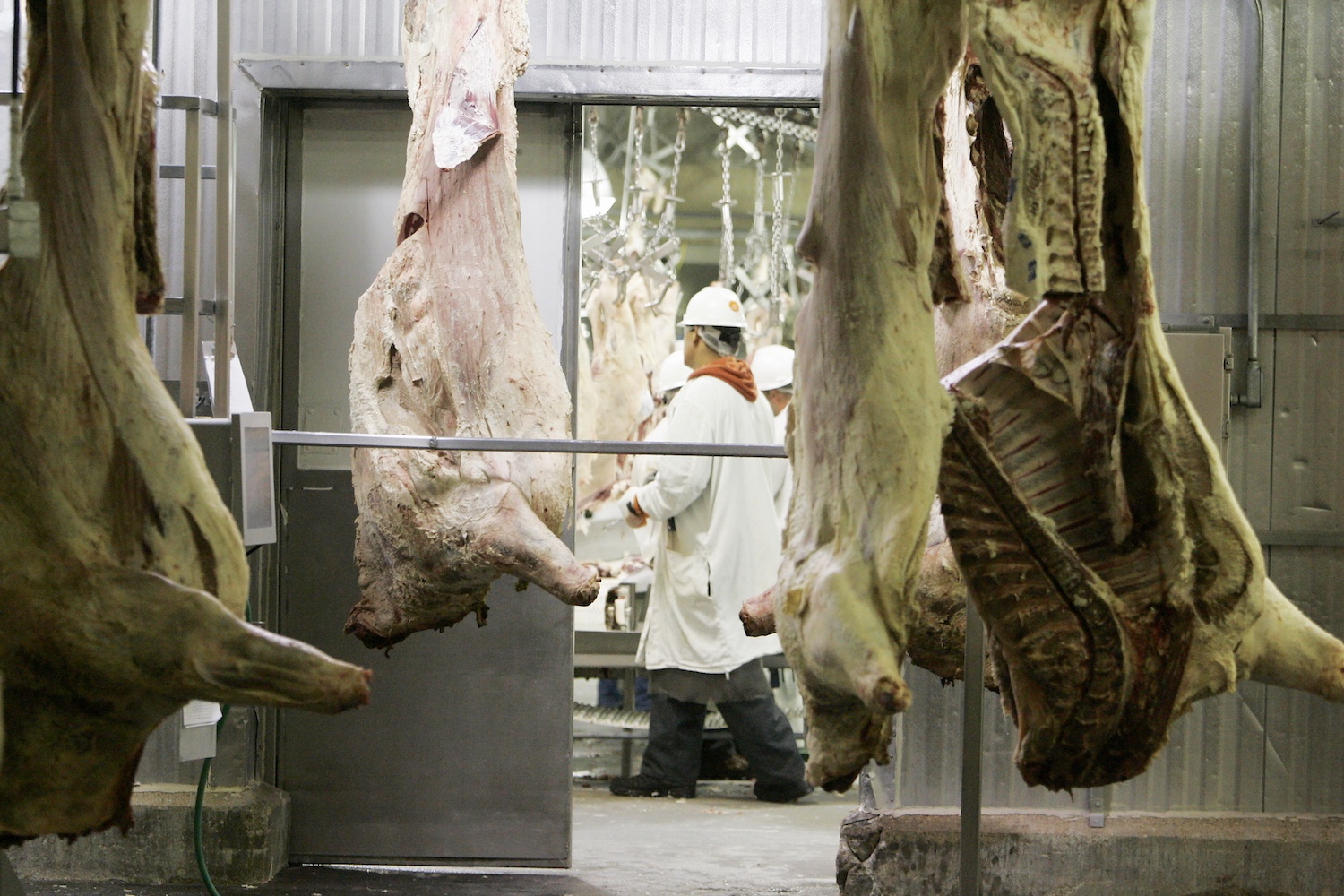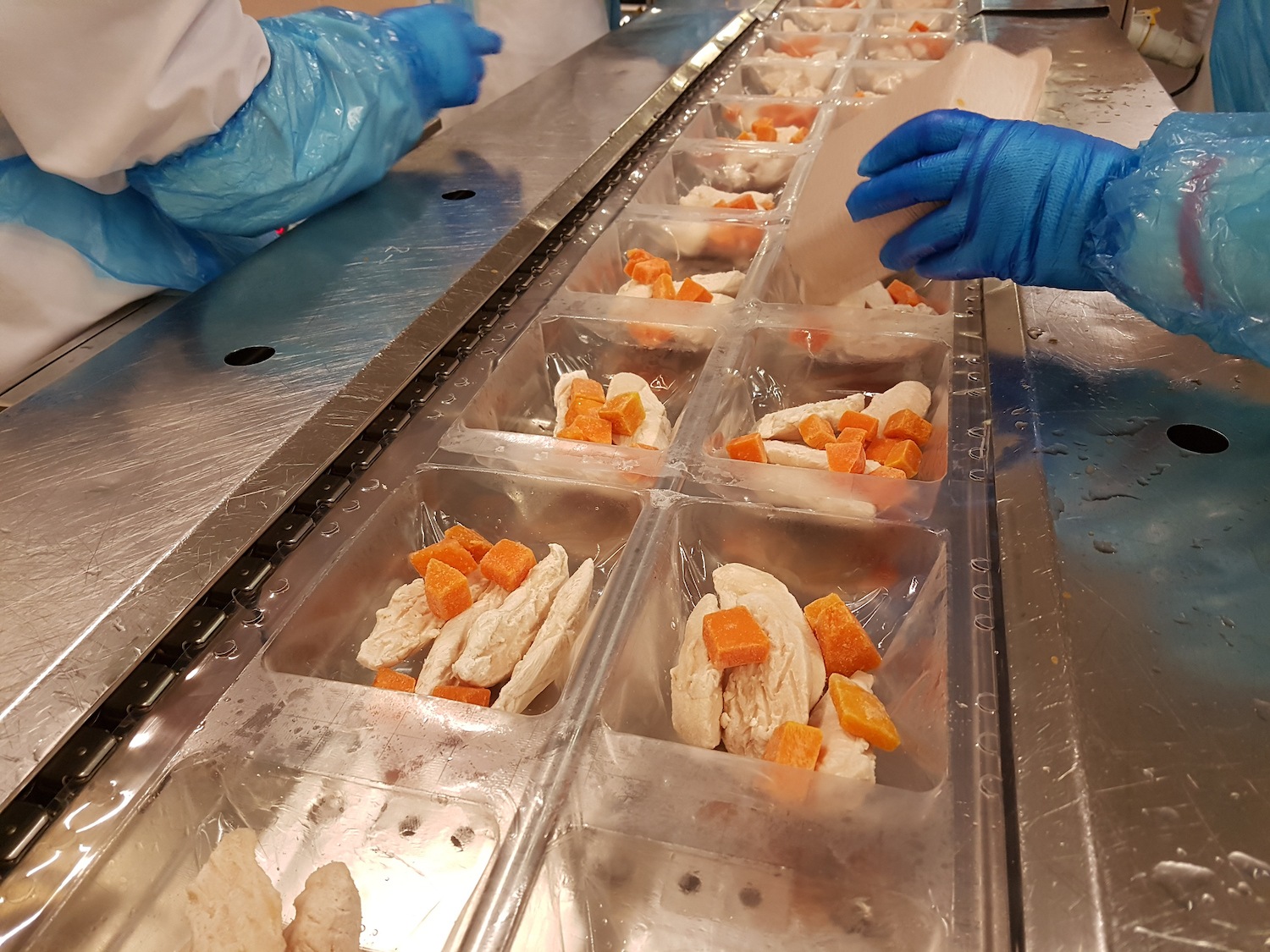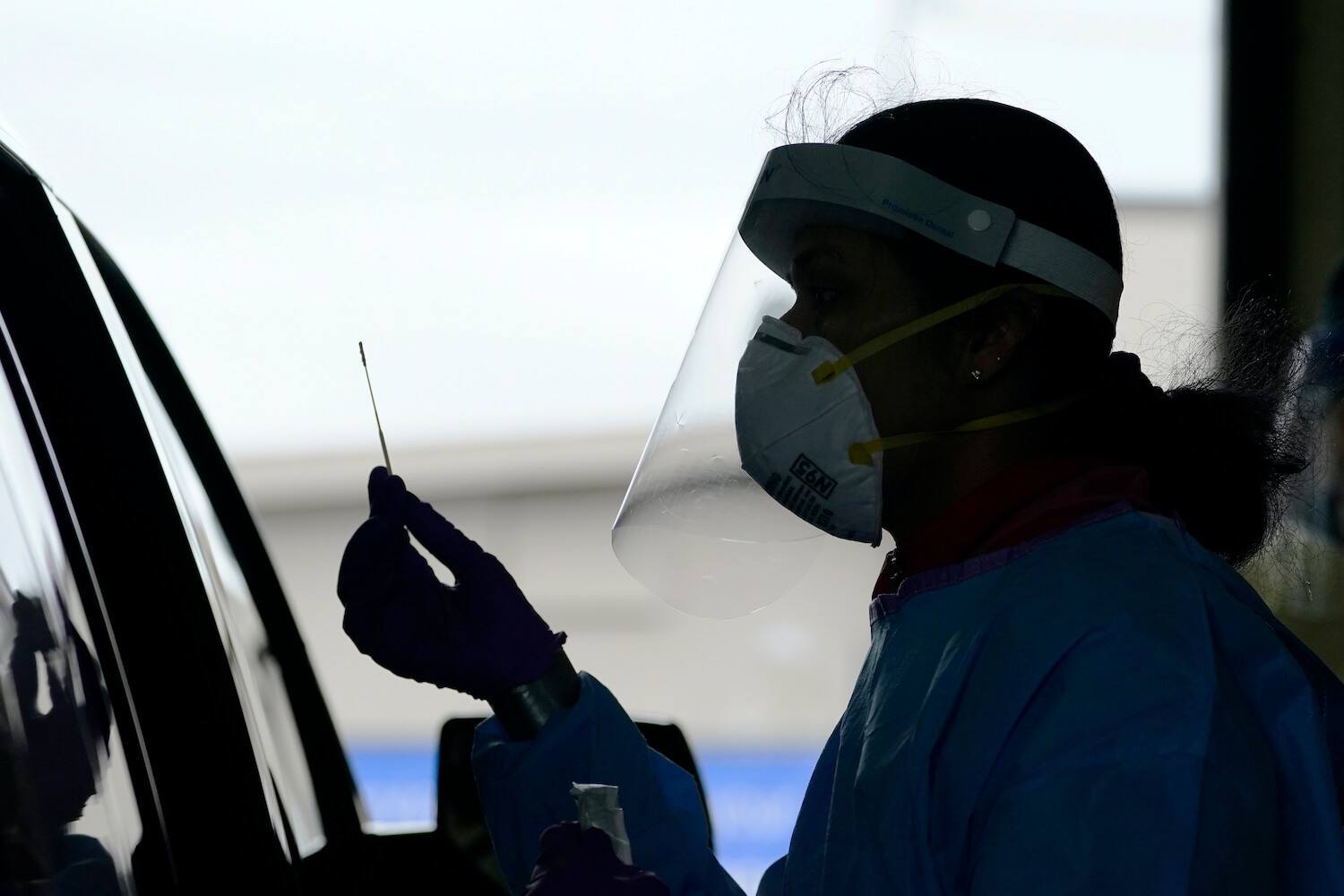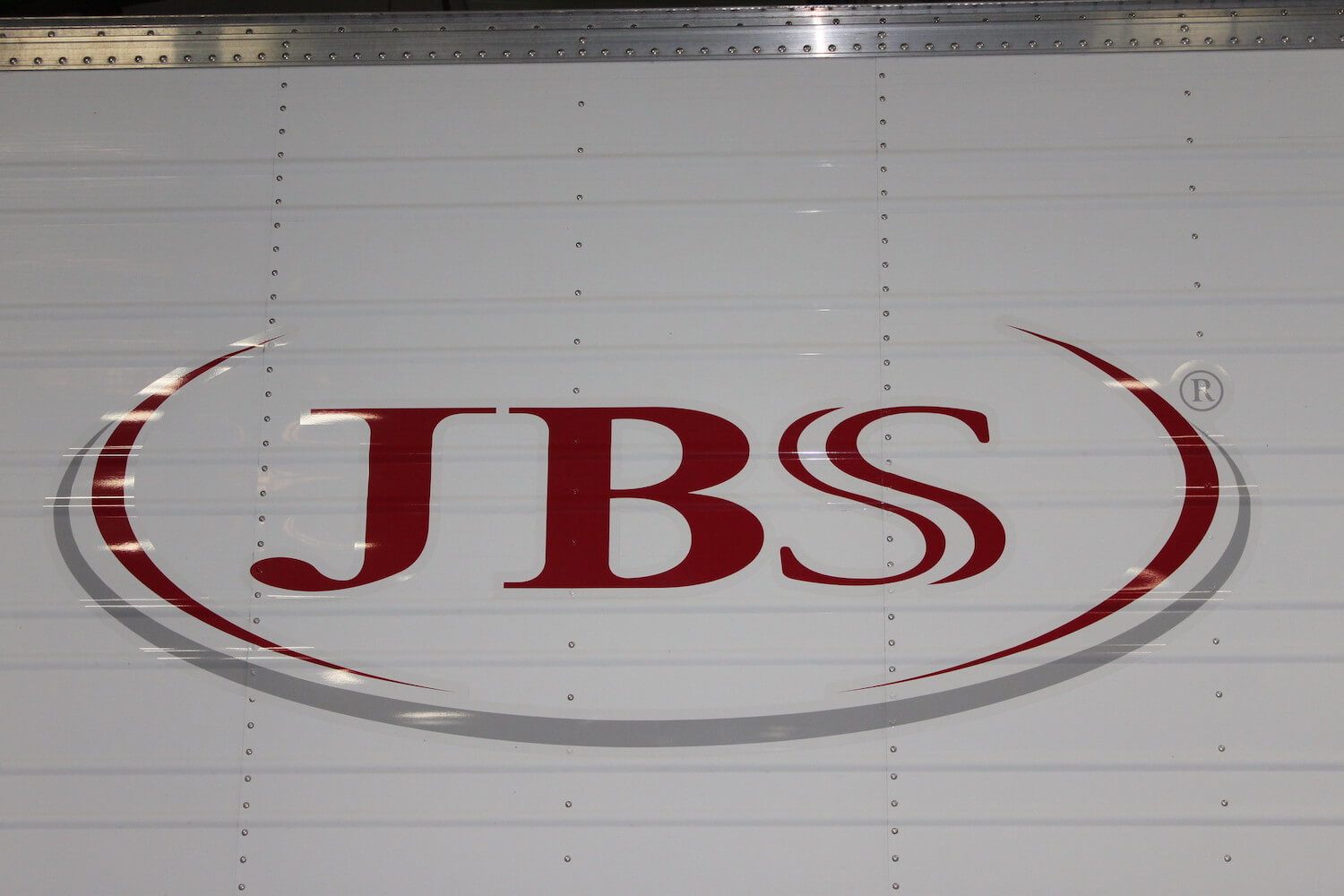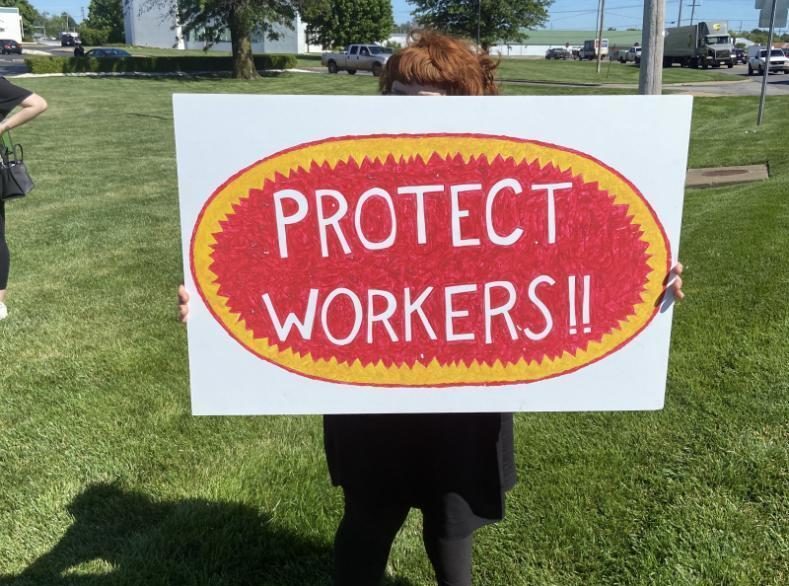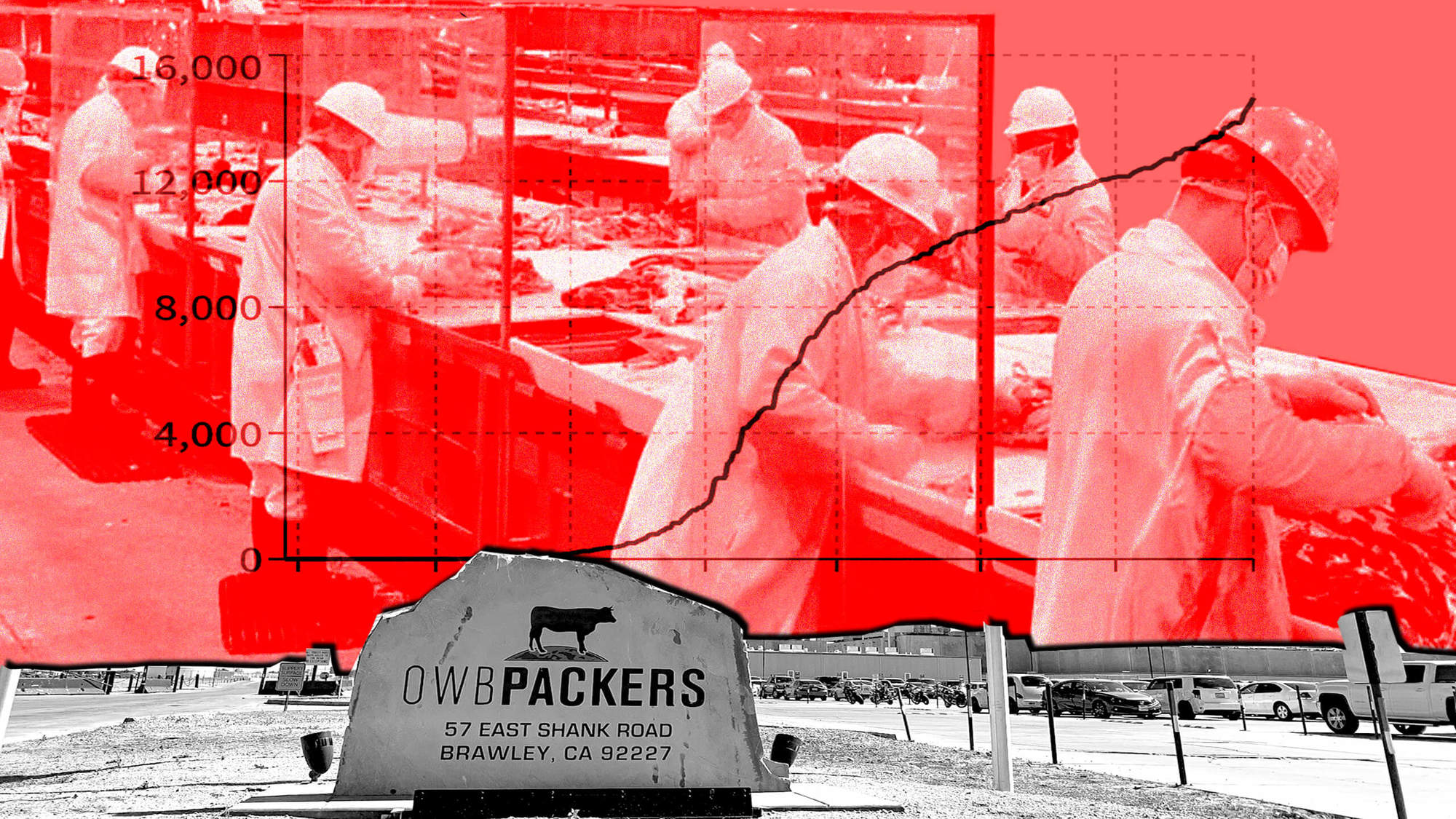
Graphic by Tricia Vuong; image courtesy of The Calexico Chronicle
In the face of an unprecedented public health crisis, the federal agency responsible for workplace safety has essentially allowed meatpackers to regulate themselves—leading to chaos, confusion, and fear in facilities across the country.
In April, as the first wave of Covid-19 infections began to spread across the U.S., the nation’s largest hotspot wasn’t in New York City. It wasn’t in Los Angeles, Chicago, Seattle, or any major urban center. It was in Sioux Falls, South Dakota, a small city of about 190,000.
Specifically, it was in the Smithfield Foods pork plant on the north side of town, nestled into a bend in the Big Sioux River. By April 16, 644 cases had been traced back to the plant—44 percent of all the cases in South Dakota at the time—pushing Sioux Falls to the top of the New York Times’ list of single-source hotspots. The initial outbreak only grew as the weeks and months went on. As of September, Smithfield’s Sioux Falls plant had reported nearly 1,300 coronavirus cases among its employees, about one-third of the plant’s total workforce. Four of those workers died.
For a brief period, the crisis at the Sioux Falls plant was front-page news—a stark indication of the growing problem in U.S. slaughterhouses. But the nation’s attention had largely moved on by September 10, when the federal Occupational Safety and Health Administration (OSHA) finally cited Smithfield for failing to protect its workers at Sioux Falls. The announcement of this corrective action was, in a sense, historic: Smithfield was the first meatpacker to be fined by OSHA for a coronavirus-related violation. Yet the fine itself—a mere $13,494—told a different story. The amount translated to less than $10.50 for every worker who contracted Covid-19 from the Sioux Falls plant.
American meatpackers have largely evaded responsibility for their central role in the pandemic. According to a map of Covid-19 cases in the food system by the Food and Environment Reporting Network (FERN), more than 49,000 meatpacking workers have tested positive since March. Of these, 254 have lost their lives to the virus. And yet federal and state regulatory agencies have done little to hold these companies accountable. To date, federal OSHA has imposed only about $70,000 in total fines to meatpacking companies, according to an analysis by The Counter—an amount that averages out to less than $1.50 per confirmed infection.
In fact, Smithfield’s penalty turned out to be one of the harshest: The vast majority of meatpackers have faced no penalty whatsoever. Though FERN’s tracker has found coronavirus outbreaks at 548 meatpacking plants nationwide, only six packing plants, owned by a total of four companies, have been cited by OSHA. As of this writing, state-level OSHA agencies have fined several more.
“The number of citations are paltry. The amount of money that has been cited has been trivial for these companies,” said Robert Harrison, an occupational medicine specialist at the University of California San Francisco who was formerly a representative on California’s Occupational Safety and Health Standards Board, speaking of federal citations. “This is unprecedented in my lifetime. I have never seen such a complete failure in my career.”
[Subscribe to our 2x-weekly newsletter and never miss a story.]
If the federal government isn’t using financial penalties to hold meatpackers accountable, what regulatory mechanisms are being used to keep workers safe? The astonishing reality is that no Covid-specific worker protections exist. Slaughterhouses were counted among the most dangerous work environments even before the pandemic, but federal and state agencies have given these facilities broad latitude—essentially allowing them to design their own Covid-19 protection plans. Though the Centers for Disease Control and Prevention (CDC) and OSHA have issued a joint guidance for meatpacking and food workers, first published on April 26 and updated continuously since then, those new guidelines are voluntary and carry no legal weight.
“The number of citations are paltry. The amount of money that has been cited has been trivial for these companies.”
“OSHA’s guidance documents are not standards or regulations, and they create no new legal obligations,” a Department of Labor spokesperson told The Counter. “The recommendations are advisory in nature, informational in content, and are intended to assist employers in providing a safe and healthful workplace.”
This lack of Covid-specific safety regulations is not unique to meatpacking. Since the pandemic began, federal OSHA has so far issued 232 coronavirus-related citations, always for violating rules that existed before the pandemic. What is unique is the broad legal tool the agency has used to fine Smithfield and other meatpackers: the General Duty Clause, part of a 1970 law that requires all workplaces to remain “free from recognized hazards that are causing or are likely to cause death or serious physical harm.”
This approach means that meatpacking facilities operate in a tenuous kind of legal limbo. They must keep their employees generally safe. But they are not required to take measures that would protect workers from Covid-19 specifically. As long as they can strike that delicate balance, meatpacking companies are permitted to respond to the pandemic’s dangers however they like.
That flexibility might seem reasonable in theory. But it has caused chaos, uncertainty, fear, and danger in practice—repercussions that are best seen through the story of a major outbreak at a single facility, one that barely registered outside of local news reports until now.
Unlike the outbreak at Sioux Falls, this outbreak never made national headlines. It’s not associated with a company like Smithfield Foods that is a household name. But its impact was nonetheless devastating to workers and their families—and helps reveal how the federal government’s larger failure to provide meatpacking workers with even the most basic assurances of safety has thrown an essential workforce into a state of upheaval, putting lives at risk.

The outbreak at One World Beef Packers in Brawley, California—one of the state’s largest slaughter facilities—helps illustrate the federal government’s reluctance to regulate meatpackers during the Covid-19 pandemic.
Courtesy of The Calexico Chronicle
One World Beef Packers operates one of the largest slaughterhouses in California, and the only one in Imperial County. Its plant in Brawley—which employs more than 900 workers and can process more than 1,000 head of cattle in one day—was the site of a significant Covid-19 outbreak earlier this year. According to our extensive conversations with current and former employees, the company struggled to keep its workers safe since the onset of the pandemic. Of the dozen workers we interviewed, five say more than 200 employees have tested positive for Covid-19. One worker has died. Yet One World Beef has continued to process meat continuously without penalty from federal or state regulatory agencies.
Update, January 26, 2021: One month after this story was published, Cal/OSHA, California’s state-level agency overseeing workplace safety, fined One World Beef $23,000 for coronavirus-related violations. Specifically, the company was fined $18,000 for allowing workers to work too close together while failing to provide protective barriers. It was fined $5,000 for failing to report three instances of serious illnesses as required by law. One World Beef has still not received penalties from federal OSHA as of this writing.
One World Beef’s story parallels the situation at slaughter facilities throughout the United States. The virus first spread through the company’s workforce in March and April, before federal and state-level guidelines were issued. In the absence of clear directives, One World Beef devised its own safety standards. As workers began to fall ill, a lack of adequate testing hampered detection. Through it all, the company tried to continue business as usual—in fact even increasing the pace of work as supply shortages spooked the nation and raised the price of beef.
To be fair, our reporting found that One World Beef was more proactive in designing new health and safety practices than many meat facilities in the state and across the country. The company instituted increased sanitation protocols and provided workers with gloves and masks as early as mid-April. But the company’s overall failure to prevent illness is a dramatic indication of how badly the current regulatory stance has fallen short. The voluntary measures taken did little to prevent the raging outbreak that led to one man’s death.
One World Beef continued to process meat continuously without penalty from federal or state regulatory agencies, despite having more than 200 employees who have tested positive for Covid-19.
Meanwhile, as the nation heads into the pandemic’s devastating third wave, One World Beef employees report that social distancing and other precautions are not compatible with existing practices. But the facility, like others across the country, lacks incentive to adopt practices that would protect workers if it means slowing plant’s output. As of press time, the company is one of nearly 670 meat processing facilities in California—including slaughterhouses, processing plants, and distribution warehouses—to have received no fines related to Covid-19.
One World Beef did not respond to repeated requests to comment for this story.
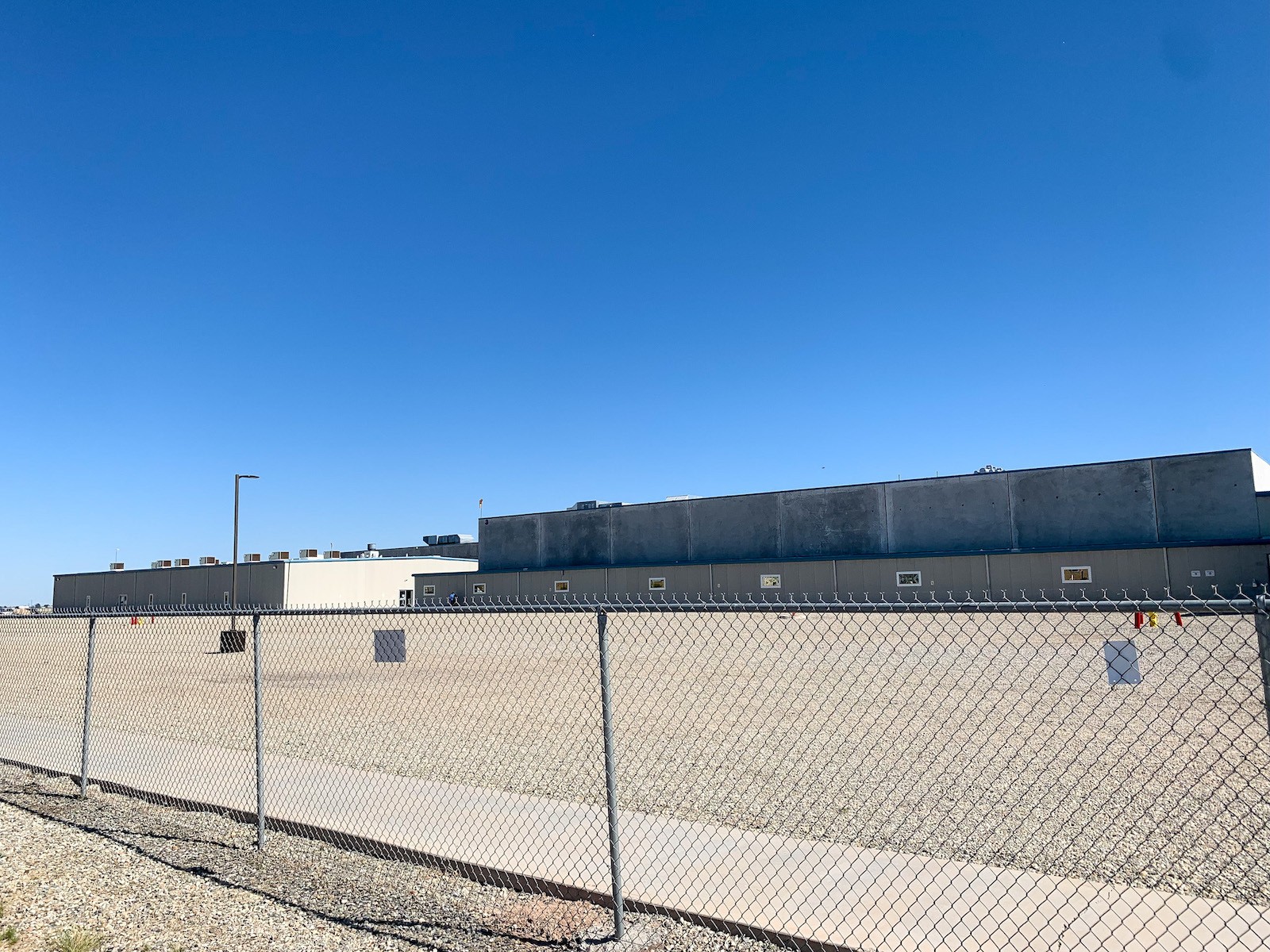
One World Beef’s plant in Brawley employs more than 900 workers and can process more than 1,000 head of cattle in one day. According to current and former employees, more than 200 of the plant’s workers contracted Covid-19 during March and September.
Courtesy of The Calexico Chronicle
—
On mornings in March, work began as it always did for employees of One World Beef (OWB) Packers. Many who work at the facility live 30 miles away from Brawley in the border city of Mexicali, Mexico, waking each day before dawn to join the slow queue across the border. Though it can be physically grueling labor, employees who live in Mexico told The Counter that the wages and benefits at One World Beef allow them to live in relative wealth in Mexicali. But, this spring, the prospect of a new occupational hazard started to unsettle workers: In the middle of April, as the first counties in California enforced shelter-in-place orders, One World Beef leadership announced that an employee had contracted Covid-19.
According to a day-shift worker at the plant, to date, the company does not release any information on the number of workers who are out sick with Covid-19. And while it’s true that the specifics of any employee’s health status are supposed to remain private under the Americans with Disabilities Act, it’s also true that One World Beef likely should have gone further.
According to the interim guidance issued by OSHA and CDC, “[i]f a worker is confirmed to have COVID-19, employers should inform anyone they have come into contact with (including fellow workers, inspectors, graders, etc.) of their possible exposure to COVID-19 in the workplace.” That didn’t happen at One World Beef—though, to be fair, that guidance was not issued until April 26th, weeks after cases began to spread through the company’s workforce.
Employees were told that if they did not return when their paid leave ended, they would risk being replaced. That culture of fear led to employees showing up to work sick.
Instead, One World Beef’s workers were left in the dark. Fearful employees were told they could take paid vacation, but they would need to return to work after two weeks. When they did return, there would be no guarantee of safety—but employees were told that if they did not return when their paid leave ended, they would risk being replaced.
According to two employees, anyone who presented Covid-19 symptoms was required to notify the plant by leaving a voicemail with human resources, and expected to quarantine themselves for two weeks. But that policy was apparently not enough to keep employees from working while ill. Multiple workers told The Counter that employees were often afraid to call in sick, concerned they would lose their job or would not be paid sick leave. That culture of fear led to employees showing up to work sick. One 30-year-old employee from Mexicali, who asked to remain anonymous for fear of retaliation, said that he found himself working closely in the fabrication floor with co-workers who displayed symptoms of Covid-19.
Pedro Ruiz, a former One World Beef employee, is also a friend of the first employee who tested positive for coronavirus at the plant. Ruiz said his friend carried the virus home to Mexicali, where it spread to both his mother and brother. The employee was eventually hospitalized and put on a ventilator. On April 15, while he was still hospitalized, the employee’s mother passed away of Covid-19 complications.
—
According to the One World Beef employees we interviewed, the company started instituting basic safety practices early on—measures like spacing out seating in break areas and installing plastic dividers where employees eat. OWB did not respond to our questions about safety measures taken, but in a piece published April 30, CEO Eric Brandt explained the company’s protocols to a reporter for The Desert Review. “We began our safety measures for the COVID-19 virus back in early March,” he said. “When employees reach the entrance to the plant, which is located a few hundred yards outside of the plant, the pre-entrance protocols begin. Temperatures are taken, hand sanitation is administered, gloves and facial coverings are supplied, and soles of shoes are sanitized.”
Providing personal protective equipment and administering temperature screens were important steps taken by One World Beef. But the experts we spoke to for this story detailed numerous other steps that meatpacking facilities can take to make their operations immediately more safe for workers. These include slowing down the trim line, spacing workers out sufficiently, improving ventilation, telling workers when they might have been exposed to the virus, not incentivizing coming to work every single day, and providing routine testing for all workers, especially new hires. One World Beef, according to the workers we interviewed, did not take any of these critical steps and, in some cases, did the opposite.
The company’s approach to testing turned out to be especially problematic.
In early April, One World Beef still hadn’t started to provide routine testing. According to multiple employees, the company had told its workers the virus was under control. Still, fear permeated the plant.
Tensions finally exploded on April 13, when more than 100 workers on the plant’s morning shift refused to enter the facility. They demanded the company improve its sanitation practices, make Covid-19 testing available, and guarantee they would not be fired for refusing to enter that morning. After standing outside for three hours, the workers were finally directed by One World Beef to get tested at All Valley Urgent Care, a clinic 20 miles away. One World Beef set up a partnership with the clinic where workers could be tested at no cost. The line to get tested stretched through the shopping center parking lot.
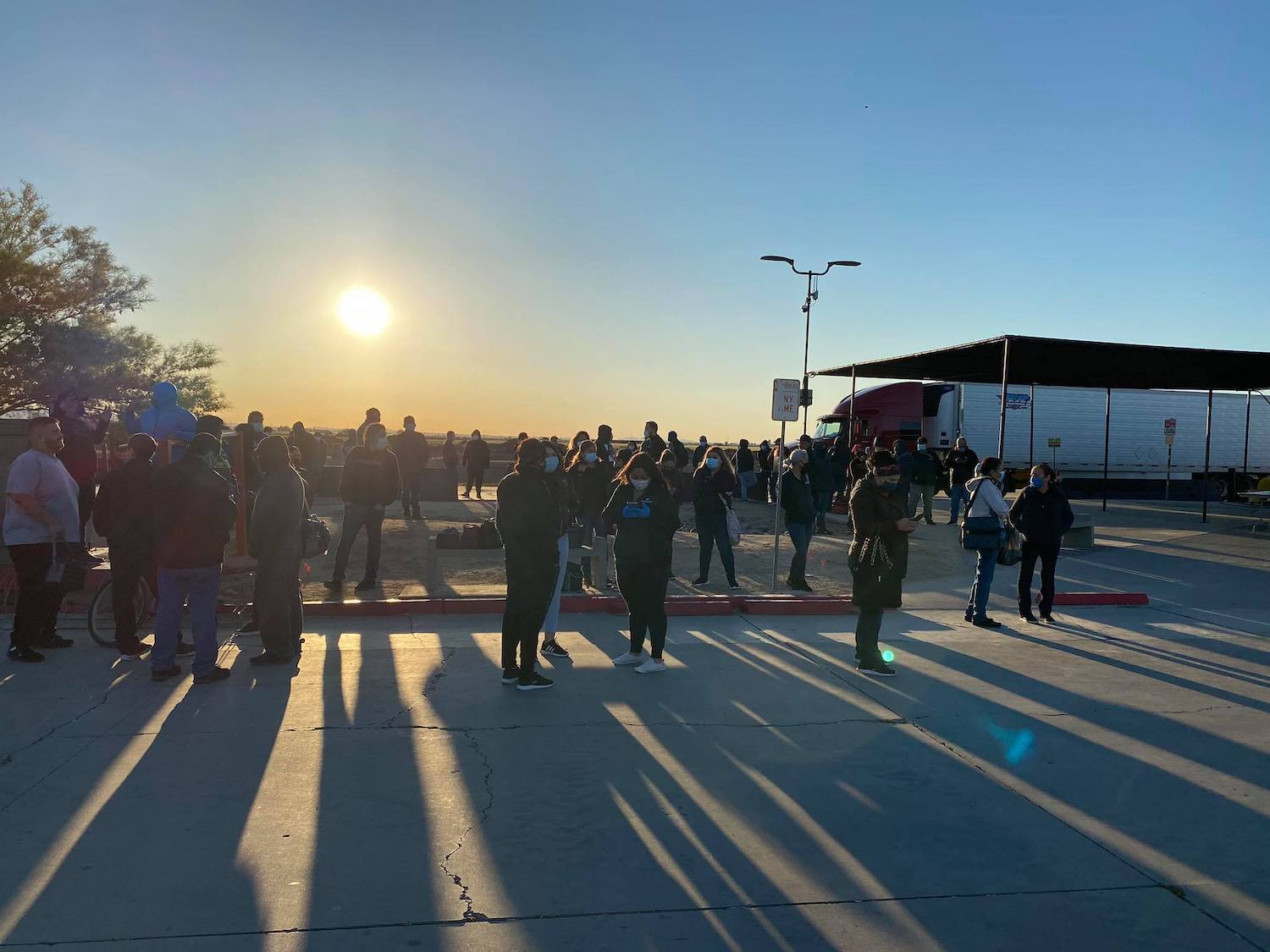
On the morning of April 13th, more than 100 workers at One World Beef’s plant in Brawley, California refused to enter the facility due to safety concerns.
This photo was shared in a private Facebook group for OWB employees that was viewed by The Counter.
“We tested between 300 and 400 people from the facility on that first day,” said Dr. Brian Tyson, the owner of All Valley Urgent Care.
Though this was an encouraging step, many employees were confused by the test that was administered. Rather than the widely publicized nasal swab test, employees received a finger pinprick combined with pulmonary X-rays. The employee confusion was justified: As it turned out, the testing method did not measure if employees were actively infected. But All Valley Urgent Care did not have nasal swab tests that would have made testing for active infection possible.
The medical provider used by One World Beef for Covid-19 testing did not have nasal swab tests that would have made testing for active infection possible.
A lack of available nasal swabs had hit the county hard: No swabs were allocated to the region’s hospitals or clinics by the state or federal governments until May. In March and April, Vo Medical Center was the county’s only clinic with nasal swabs available, a surplus used to test for strep throat and influenza before the Covid-19 pandemic. In those early days, Vo Medical Center donated 100 tests to the Imperial County Department of Public Health to be distributed to the county’s two hospitals. Venus Nguyen, a family nurse practitioner at Vo Medical Center, said her clinic was not approached by One World Beef to perform testing.
Dr. Tyson said via text message that One World Beef employees “were told we were using antibody tests and CXR [chest X-rays] because nobody had swabs available,” and were given a consent form that further explained the test. The consent form included the following qualification: “This test has not been reviewed by the FDA. Negative results do not rule out SARS-CoV-2 Infection, particularly in those who have been in contact with the virus.”
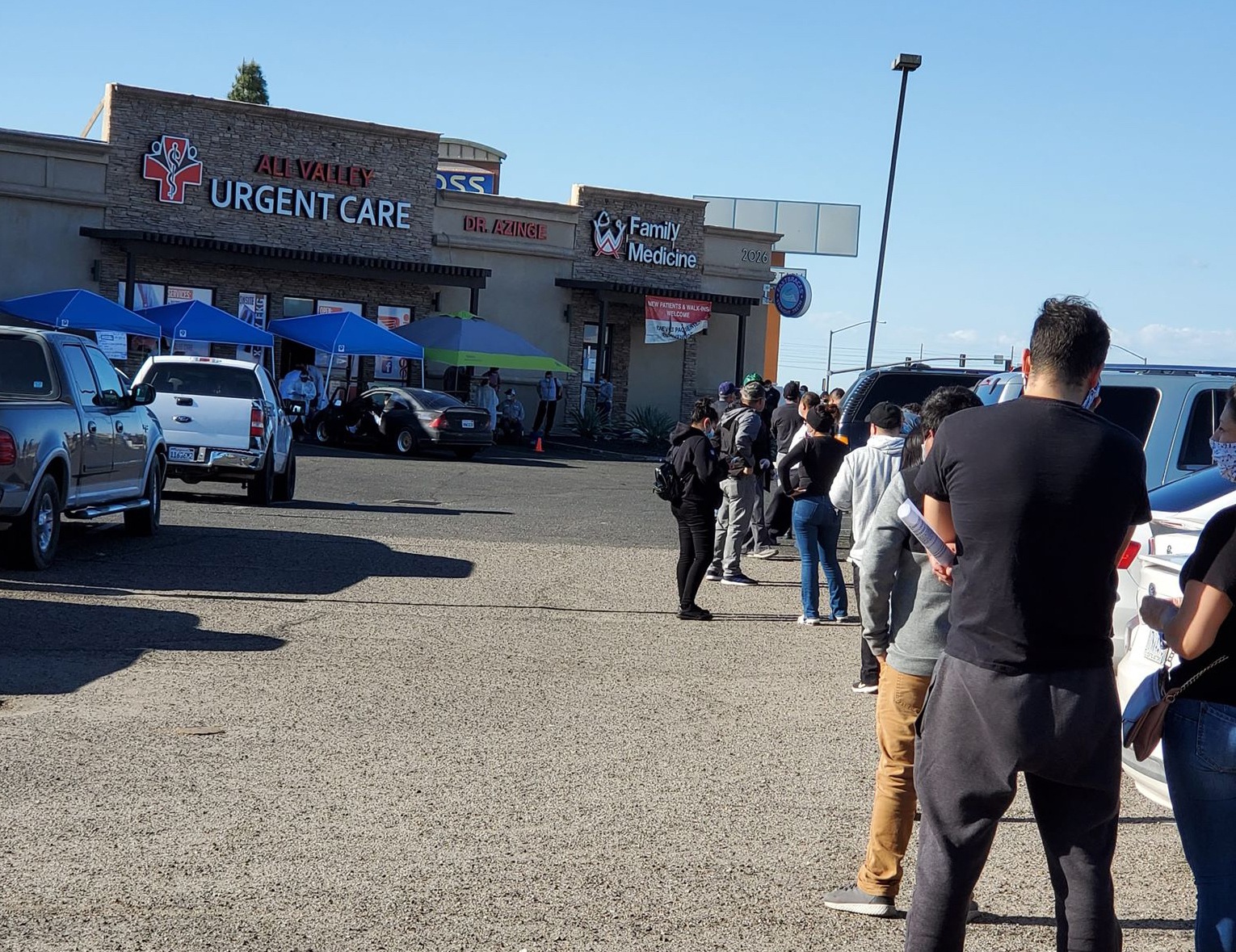
On the first day that One World Beef offered free Covid-19 testing to workers, between 300 and 400 employees showed up. The testing method used, it turned out, was not approved by FDA for Covid-19 detection.
This photo was shared in a private Facebook group for OWB employees that was reviewed by The Counter.
The test the clinic administered—an antibody test—measures a patient’s immunity to the virus, rather than a viral test, which determines if a patient is actively infected with Covid-19. Symptomatic patients were told not to return to work until they could be retested after seven days.
Dr. Tyson said consent forms were available only in English for the first week of testing, but the procedure was explained to non-English speaking employees if needed. Even so, the test remained unclear to many employees.
A One World Beef employee invited us to a private Facebook chat where workers shared their confusion about the test and encouraged one another to get a second test done at Vo Medical Center. Some workers were cleared to go back to work after being tested at All Valley Urgent Care but tested positive when given a nasal swab test at Vo Medical Center.
“This test has not been reviewed by the FDA. Negative results do not rule out SARS-CoV-2 Infection, particularly in those who have been in contact with the virus.”
As One World Beef did not respond to requests for comment, it’s not known whether the company understood its tests were grossly insufficient, or if it realized that confusion about testing abounded in the workplace. But at least one company manager had a fatalistic attitude about infections at the plant. In June, a human resources employee told Daniel Estrada, a former OWB worker, that it was just a matter of time before everyone got the virus. “From what I’ve seen, we will all have it sooner or later. We just really need to be careful,” the human resources employee said, in a text message reviewed by The Counter.
In other words, as long as work continued, employees were going to keep on getting infected.
—
On April 26, CDC and OSHA released their interim guidance for meat and poultry processing workers. Framed as a series of recommendations, the document gave detailed instructions intended to keep packing facilities running safely, despite the threat of Covid-19—though, as noted above, these recommendations were strictly voluntary.
If the interim guidance left any doubt about its legal enforceability, those doubts were quickly dispelled. On April 28, President Trump signed a controversial executive order that used the Defense Production Act to force meat plants to stay open. “The order is designed in part to give companies legal cover with more liability protection in case employees catch the virus as a result of having to go to work,” Reuters reported. Speaking in the Oval Office, the president told reporters that the order would “solve any liability problems.” (Later, ProPublica would report that much of the order’s language was drafted by meat industry groups.)
Instead of taking precautions that would have slowed the pace of work, One World Beef cranked up its output during a time when it was financially advantageous to do so.
This turn of events left meatpacking workers utterly at the mercy of their employers. Ordered to remain open by the president, ostensibly shielded from liability for doing so, and with only voluntary recommendations to guide them, packing companies had broad flexibility in deciding how to operate.
In theory, a plant like One World Beef could have proceeded with its people—and not just its profits—in mind. As Robert Harrison, the former California Occupational Safety and Health Standards Board representative, put it, “Responding to [Covid-19] requires an unprecedented commitment that starts with the concept that meatpacking plant workers are not expendable.”
Instead, One World Beef—like other meatpacking companies across the country—sent the opposite message, making clear to its employees that they were replaceable. What mattered most, it seems, was ensuring that beef got processed.
As the outbreak began to take hold within One World Beef’s plant, the company did not slow the pace of production. Instead, its fabrication line processed animals at a significantly faster rate, requiring workers to also work much faster.
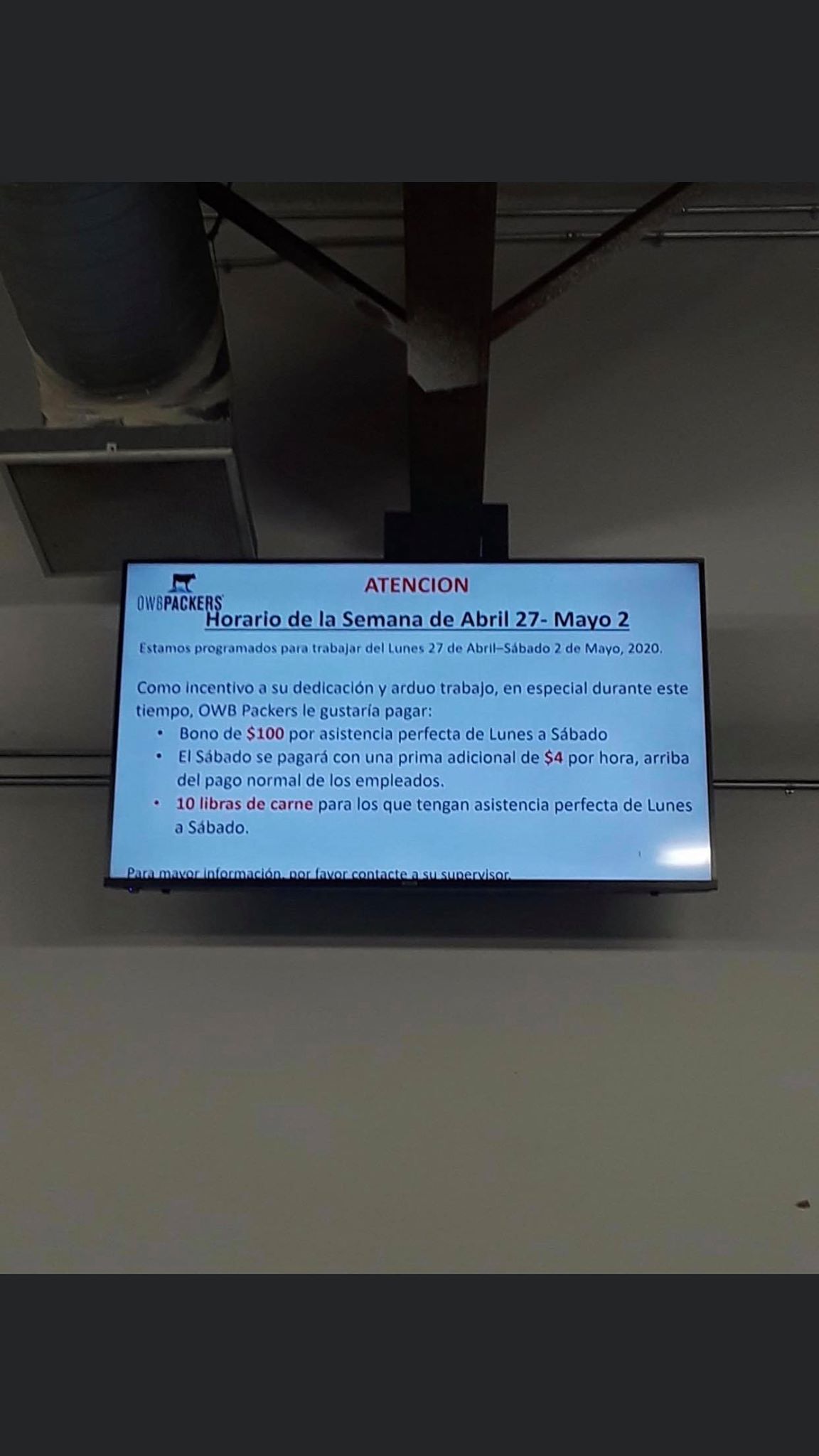
As the outbreak worsened, One World Beef offered bonuses to employees for coming to work.
Above, signage within the One World Beef plant spells out the details of incentives given between April 27 and May 2.
This image was posted to a private Facebook group for OWB employees that was reviewed by The Counter.
Under the previous owners, Brawley Beef (National Beef), the plant had the capacity to slaughter between 1,600 to 2,300 cattle on a daily basis. When One World Beef took over in 2015, CEO Eric Brandt said the company’s focus was on the quality of the meat over quantity, and would run a more streamlined operation—building gradually to a 700- to –1,200-cow daily capacity over the course of several years.
One OWB worker said that on a regular five-day week before Covid-19, employees would slaughter between 800 to 1,200 cows a day. But in spite of the ongoing pandemic, production at One World Beef Packers increased in the spring. In March, April, May and June, on average 1,500 cows were slaughtered every day, six days a week according to an employee who works in fabrication, the last stage of production at the plant.
In other words, the company cranked up its output during a time when it was likely to be financially advantageous to do so. U.S. cattle slaughter rates dropped precipitously during that four-month span; at its lowest point in late April, beef processing was at 60 percent of its previous year’s capacity. At the same time, and likely as a result of plant closures, wholesale beef prices jumped markedly during the period between April and June. For packing plants that managed to stay open, processing as many cattle as possible could be highly lucrative—even if it posed serious risks to worker health.
As fears around the pandemic grew, more and more workers began staying home from work, leaving One World Beef understaffed. In an attempt to maintain the brisk rate of production, the company offered weekly bonuses throughout April. Workers who came to work Monday through Saturday without missing a day were given a bonus of $50, later raised to $100, which was accompanied by a box of meat valued at $200 to $300.
Workers were told if they were scared to enter the facility, they could refrain from coming to work, but multiple employees told us they were warned by supervisors they might be transferred to another area of the plant, be demoted, or replaced altogether if they chose not to come.
Given the increased workload, and the realities of the plant’s built construction and daily operation, social distancing continued to be impossible.
At the same time, many new employees were hired to help increase production even further, according to two One World Beef employees. In mid-April, approximately 900 employees worked on two main shifts at the plant. One World Beef would later announce, at a meeting between the company and employees in mid-August, that its workforce had grown to over 1,100 people.
The new workers were not just to increase capacity. They were also intended to make up for the loss of existing employees who did not feel safe coming to work.
“They’ve been hiring so many new people,” one former employee told us, “because so many people are scared to enter the plant.” She decided not to return to work after maternity leave for fear of infecting her newborn child. Her husband, also a One World Beef employee, began receiving regular phone calls from the company’s human resources department, warning him if he did not return he would be replaced. In the end, he never went back.
“Workers who are sick or not working anymore are just resigned. We are disposable in this company.”
Another employee said One World Beef did not hesitate to replace workers who missed work. “Workers who are sick or not working anymore are just resigned. We are disposable in this company,” he said.
But that was likely not enough. Many employees were afraid to miss work—despite the risks—because it meant they would not be able to provide for their families. A 33-year-old employee who asked to remain anonymous for fear that speaking out would cost him his job said there’s no way to stay 6 feet away from one another on the kill floor, especially with the increase in production and number of people working at the plant. Given the increased workload, and the realities of the plant’s built construction and daily operation, social distancing continued to be impossible.
That decision ultimately had fatal consequences. In late May, a One World Beef employee named Felipe Martinez fell ill. Workers in the plant spoke fondly of Martinez, a janitor, and said he had a great sense of humor.
“He always made jokes, and his first instinct was to help anyone who needed it,” said Pedro Ruiz, a friend of Martinez and a former employee of One World Beef.
By the time Martinez’s condition worsened, in early June, Imperial County’s two hospitals were already overburdened with patients. Martinez was flown out of the county to be hospitalized, along with 500 others over a three–month period. He ended up at the Desert Regional Medical Center in Palm Springs, 95 miles from Brawley. Soon after arriving, he slipped into a coma. Ultimately, on June 16, Martinez died from acute respiratory distress syndrome, pneumonia, and Covid-19.
—
In early September, Cal/OSHA—California’s state-level OSHA agency—issued fines against four food processing facilities. The largest fines, for $200,000, were leveled against both Overhill Farms, a frozen food manufacturer in Vernon, and Jobsource North America Inc., the temporary employment agency that provides the company with workers. The press release on the Overhill Farms citation stated that the company exposed workers to serious illness by failing to implement physical distancing throughout the facility, including “where they clock in and out of their shift, at the cart where they put on gloves and coats, in the break room, on the conveyor line and during packing operations.”
More recently, on November 11, Cal/OSHA fined Smithfield Foods $55,850 for a range of Covid-related violations at its Vernon plant, including improper physical distancing on multiple processing lines. The handful of fines issued by Cal/OSHA to meatpackers for violating the California Code of Regulations’ Injury and Illness Prevention Program—which includes broad provisions similar to the General Duty Clause—have generally been for higher amounts than then ones issued by federal OSHA.
This may signal a willingness on the part of the state-level agency to hold meatpackers more accountable. Still, One World Beef employees said the similar conditions were still present in the facility when federal and state-level OSHA agencies began to issue their first fines to meatpackers this fall. One worker—who tested positive for the virus in April and asked for anonymity for fear of retaliation—said that as of mid-September, physical distancing continues to be difficult throughout working areas, five months after the Cal/OSHA Interim General Guidelines on Protecting Workers from COVID-19 was released. The employee said that One World Beef is still not sharing information about the total number of employees infected with Covid-19.
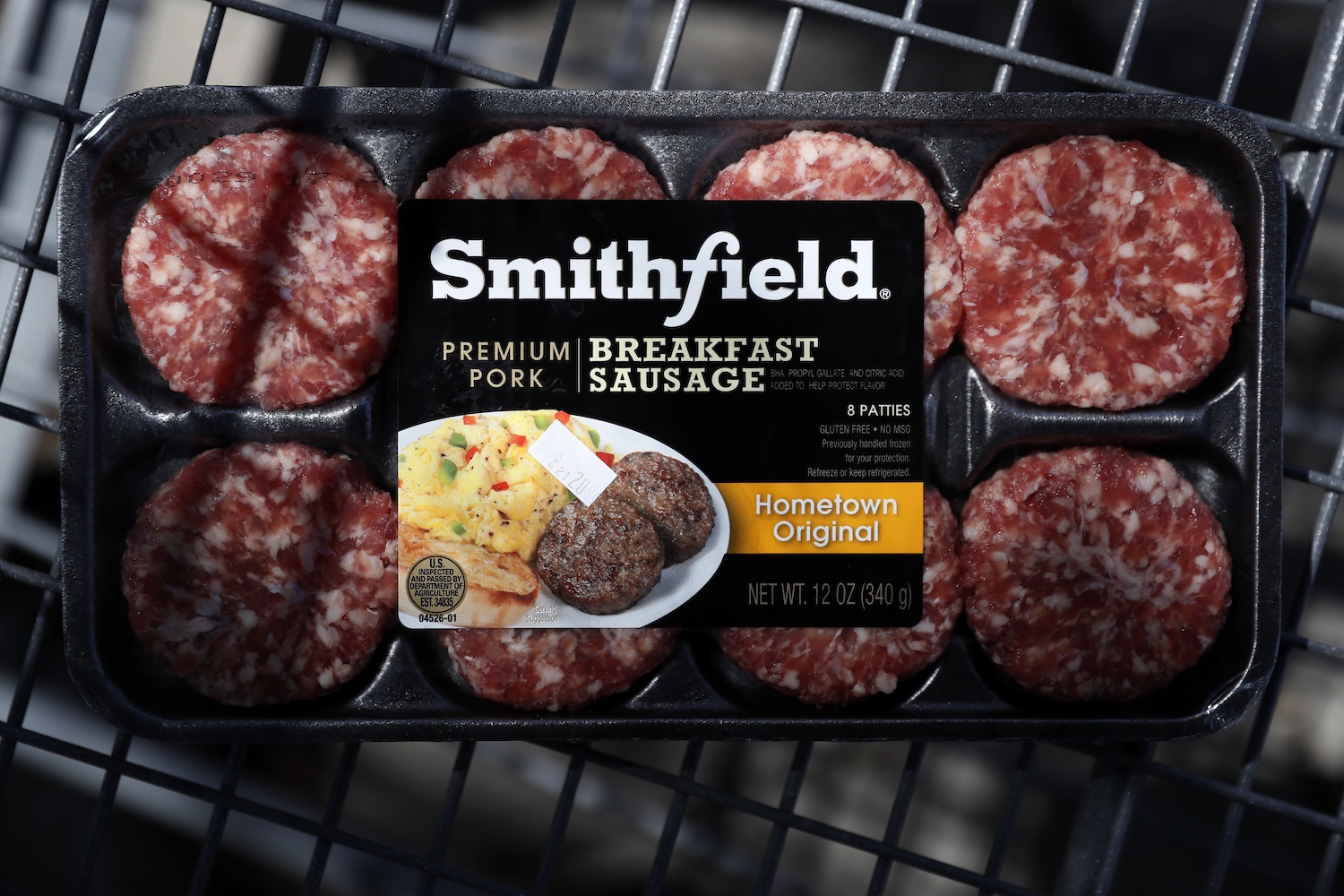
Smithfield was the first meatpacker to be fined by OSHA for a violation related to Covid-19.
AP Photo/Charlie Neibergall
Fernanda Lynch, a public information officer for the Imperial County Department of Public Health, confirmed there have been positive cases at One World Beef, and that an investigation including contact tracing was being performed. But she said the department could not release specific information, like the number of cases at the facility, or details about who was affected, to protect the privacy of individuals. Many California counties do not release information about positive cases at specific companies.
Meanwhile, federal OSHA has issued fines to only four meatpacking companies—a total of eight fines across five facilities—since the pandemic began.
OSHA officials have claimed that existing guidelines are enough to protect workers from the virus. In October, Loren Sweatt, the head of OSHA, penned an op-ed that said “OSHA packaged crucial information in a single Guidance on Preparing Workplaces for COVID-19, outlining how to prevent COVID-19 spread in the workplace and actions to keep workers safe. … The Trump administration ensured that processors and producers continued to follow the important CDC and OSHA guidelines for worker and workplace safety.” She has also told the House Subcommittee on Workforce Protections that “regulations are very cumbersome to revise.”
“I have concluded that, after worker outbreaks at more than 350 meatpacking plants, that the industry cannot regulate itself.”
Labor experts disagree. Writing in a New York Times editorial, AFL-CIO President Richard Trumka called the voluntary guidance issued by CDC and OSHA “wholly inadequate.”
“They can do what they want,” said David Michaels, the former assistant secretary of OSHA under President Obama, speaking of meatpacking companies. “They decide how much to protect workers and how much they are not going to and what sort of investments they are going to make. And that’s obviously been a failure.”
Michaels said that using the General Duty Clause as a catchall to enforce Covid-19 violations is a doomed strategy.
OSHA has the ability to treat each worker exposed to Covid-19 as a separate violation, a move that would dramatically increase the financial penalty.
“You can’t go to one employer and say, ‘Look, we issued a citation under the General Duty clause against a different employer and you have to do the same thing,” said Dr. Michaels. “That doesn’t work.” It only works, he said, “if you have a standard.”
As Robert Harrison put it: “I have concluded, after worker outbreaks at more than 350 meatpacking plants, that the industry cannot regulate itself.”
A former OSHA official, who was authorized to speak only on background, also brought up another issue with the way federal OSHA has regulated during the crisis. The agency has claimed that the three nominal fines it has issued to meatpackers for General Duty Clause violations are “the maximum allowable” by law. But that’s not strictly true. According to the former official, OSHA has the ability to treat each worker exposed to Covid-19 as a separate violation, a move that would dramatically increase the financial penalty. Calculated that way, Smithfield’s penalty for failing to protect 1,300 workers at its Sioux Falls plant would not have been $13,494. Though violations calculated this way might result in a different citation amount, a case-by-case fine at the current maximum would amount to more than $17.5 million.
The experts we spoke to agree the best way to combat the spread of the virus in meatpacking plants is to implement an emergency temporary standard that sets requirements for how plants must protect workers. “The main point of the standard,” Michaels said, “is it gives direction to many employers, or all employers, in the industry and says ‘this is what you must do.’ And the General Duty Clause doesn’t do that.”
“It’s a national tragedy that has happened.”
Such a framework exists already: The current Democratic stimulus proposal includes a federal emergency temporary standard (ETS) that would require employers to develop infection protection programs, require the distribution of personal protective equipment, institute Covid-19 safety training, forbid employers from retaliating against employees reporting violations, and require the development of a permanent infectious disease standard within the next two years.
The former OSHA official told us the Republican version of the bill would make it nearly impossible for OSHA to issue any violation citations to hold companies accountable, while limiting the ability for workers and their families to sue companies for Covid-19 related claims.
In lieu of federal regulation, a handful of states have implemented standards to protect workers. In July, Virginia passed an ETS that established “emergency regulations and standards to control, prevent, and mitigate the spread of COVID-19 in the workplace.” Michigan did the same in October, and in California, Governor Gavin Newsom signed AB-685 into law, to take effect January 1, 2021. The bill requires employers to notify their employees if they could have come in contact with the virus, report outbreaks of three or more people to county health agencies, and strengthen Cal/OSHA’s ability to regulate and shut-down offending workplaces. On November 19, the California Occupational Safety and Health Standards Board approved an emergency temporary standard that will go into effect before the end of the year.
Without a federal emergency standard, experts worry meatpacking plants across the nation will again become hotspots in the fall and winter as Covid-19 cases spike throughout the country. The federal stimulus package is currently stalled amid negotiations, and current OSHA protocols will remain in place until the proposal goes through. President-elect Joe Biden has created a set of recommendations with labor advocates, chief among them the implementation of a federal emergency temporary standard.
“It’s a tragedy,” said Harrison, reflecting on federal OSHA’s response to the COVID-19 pandemic. “It’s a national tragedy that has happened.”
Correction: An earlier version of this article erroneously stated that Robert Harrison was a former employee of Cal/OSHA, California’s state-level OSHA agency. He was instead a representative of California’s Occupational Safety and Health Standards Board. We regret the error.


